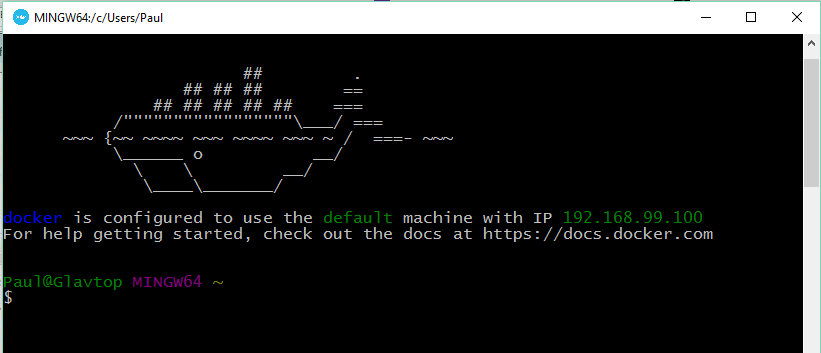
- #Kitematic docker ip how to#
- #Kitematic docker ip for mac#
- #Kitematic docker ip install#
- #Kitematic docker ip full#
- #Kitematic docker ip windows#
This makes it easier to if, for whatever reason, you want to destroy and launch a new Postgres container without losing your database data. You can simply start your container up (again) by running docker start postgres Creating a new Postgres Docker containerĭocker containers inherently don't have permanent storage, so we'll start by creating a Docker volume. Setting up and launching a Postgres Docker instance Once you've taken the following steps once, you don't need to repeat them. For example, if you're using something like Oh My ZSH you might want to add it to your. bashrc, you can add it like so: echo export DOCKER_HOST=tcp://: > ~/.bashrc Be sure to adapt this to your specific needs. To not have to add the IP address every time you run a Docker command, you can add an environment variable to your. For example: docker -H tcp://: container ls -all The default port is 2375and if you're using this can be omitted from the aforementioned command. You can run any command as you normally would from your local machine, you only need to add -H to your command with the IP address of the (virtual) machine that Docker is running on.

You should now be able to remotely access your Docker.

Save the file ( ctrl+x, y, «enter» if you're using Nano, or ctrl+c, wq, «enter» if you're using VIM), and run the following commands: sudo systemctl daemon-reload & sudo systemctl restart docker I am not sure when exactly this change was made, and if it's a permanent one or not, but the method I describe above seems to work and is also referenced here. Paste or write the following in: ĮxecStart=/usr/bin/dockerd -H unix:///var/run/docker.sock -H tcp://0.0.0.0:2375 Update: It seems like they made a change to Docker at some point that killed support for adding -H -fd://, which was the previously recommended way to have Docker listen to the default unix socket as-well. Your favorite command line text editor of choice will open with an empty file. If you're running Docker on a separate (virtual) machine, you might want to enable TCP access so you can use Docker from your local machine more conveniently.Īssuming you used systemctl (above) to start Docker at boot, run this command: sudo systemctl edit docker If you'd like to have Docker start at system boot, you can run this command: sudo systemctl enable docker (Optional) Allow TCP acces to Docker
#Kitematic docker ip full#
When the installation is finished, add your user to the docker group so you don't have to use sudo when working with Docker: sudo usermod -aG docker $USER Close and re-open your Terminal (or logout and back in if you're doing this on a remote machine) for the changes to take full effect.
#Kitematic docker ip install#
Now that everything is prepared, you can install docker community edition with the following command: sudo apt update & sudo apt install docker-ce Now add Docker's repository, this will allow you to install Docker using apt-get: sudo add-apt-repository "deb $(lsb_release -cs) stable" Start by installing the following required packages: sudo apt install apt-transport-https ca-certificates curl software-properties-commonĪnd now add Docker's official GPG key, this will allow us to add the Docker repository: curl -fsSL | sudo apt-key add. I have successfully used this on Ubuntu 16.04 as-well as 18.04 without issue, and it should work fine on other versions too although I have not tried this myself. This guide should work without issue on any recent version of Ubuntu. You can use this application to start and stop containers and modify basic settings, but you'll still need to use Terminal for some of the commands mentioned, as these are not available through Kitematic. Note: Docker Desktop comes with an application called Kitematic, which allows you to more easily control docker containers using a GUI. The first time you launch Docker it might take a few minutes for it to initialize, so wait for it to complete before you proceed. Once installed and launched, you'll see a Docker status menu icon in the top-right of your display.
#Kitematic docker ip for mac#
You can download Docker Desktop for Mac and follow its installation instructions. In case you already have Docker set up on your machine, you can skip to the next step.
#Kitematic docker ip windows#
A Mac or access to a Linux (virtual) machine (Full Windows support is outside the scope of this guide).Some familiarity with Terminal (I recommend iTerm for Mac, or cmder for Windows).


#Kitematic docker ip how to#
I have also included how to easily download and import data from a Heroku-hosted Postgres database, although the same can easily be adapted for other hosting solutions too. This is by no means the perfect or one-and-only method, but it works for my specific needs, and might help you as-well. Here are my personal notes on how to set up Postgres locally using Docker.


 0 kommentar(er)
0 kommentar(er)
